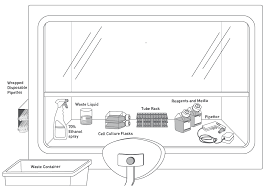
Cell culture hood
Major requirement of a cell culture laboratory is the need to maintain an aseptic work area that is restricted to cell culture work. The simplest and most economical way to provide aseptic conditions is to use a cell culture hood. The cell culture hood provides an aseptic work area while allowing the containment of infectious splashes or aerosols generated by many microbiological procedures. Three kinds of cell culture hoods, designated as Class I, II and III, have been developed to meet varying research and clinical needs.
Classes of cell culture hoods
Class I: offers a significant level of protection to laboratory personnel and to the working environment when used with good microbiological techniques, but they do not provide cultures protection from contamination. They are similar in design and air flow characteristics to chemical fume hoods.
Class II: cell culture hoods are designed for work involving bio-safety level 1,2 and 3 materials and they also provide an aseptic environment necessary for cell culture experiments. A class II biosafety cabinet should be used for handling potentially hazardous materials such as toxic reagents, virally infected cultures, radioisotopes, or carcinogenic reagents.
Class III: biosafety cabinets are gas-tight, and they provide the highest attainable level of protection to personnel and the working environment. A class III biosafety cabinet is required for work involving human pathogens and other bio-safety level 4 materials.
Cell culture hoods protect the working environment from dust and other airborne contaminants by maintaining a constant, unidirectional flow of HEPA-filtered air over the working area. The flow can be horizontal, blowing parallel to the work surface, or it can be vertical, blowing from the top of the cabinet onto the work surface. Depending on its design, a horizontal flow hood provides protection to the culture (if the air flow is towards the user) or to the user (is the air is drawn in through the front of the cabinet by negative air pressure inside). Vertical flow hood, on other hand provide significant protection to the user and the cell culture.
Reference:
1. Cell culture basics handbook, Invitrogen, GIBCO



